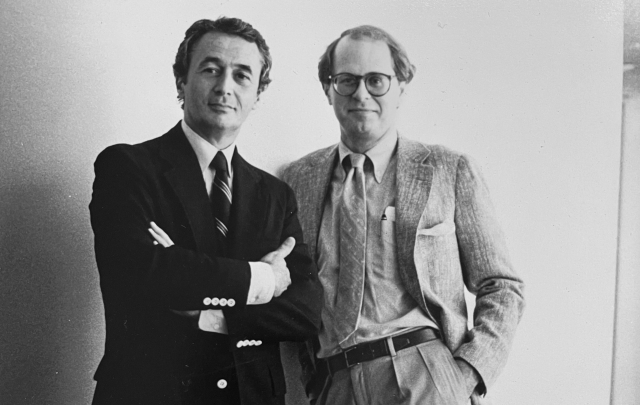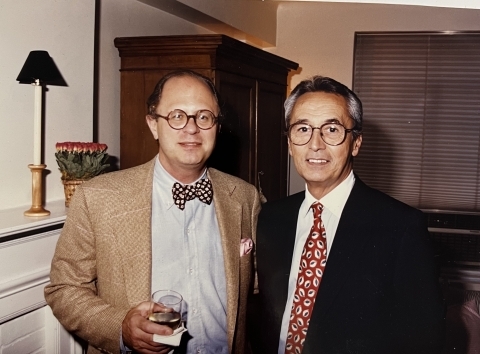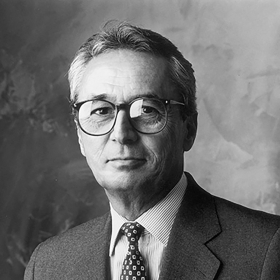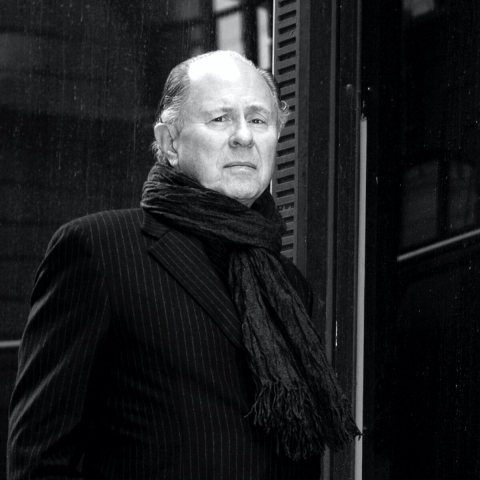

Ammirati & Puris Archive at St. John's University
- Home
- Academics
- Our Schools and Colleges
- The Lesley H. and William L. Collins College of Professional Studies
- Ammirati & Puris Archive at St. John's University
Welcome to the Ammirati & Puris Archive, a digital exhibition curated by the Lesley H. and William L. Collins College of Professional Studies (CCPS). Immerse yourself in the fascinating world of advertising history through the visionary eyes of Martin Puris and Ralph Ammirati. This exhibition is dedicated to preserving the legacy of Ammirati & Puris. Explore their iconic contributions to advertising that transformed brands into the household names they are today.
The Ammirati and Puris Archive
“Every detail matters. Great ideas move the world. Vision without execution is hallucination. Hire people smarter than you are. Nice people count.” - Martin Puris
In 1974, Martin Puris founded his agency Ammirati & Puris (A&P) with his partner Ralph Ammirati. Ammirati was the art director, while Puris was the copywriter, and together, they revolutionized advertising as we know it. From BMW’s (“The Ultimate Driving Machine”), Club Med (“The Antidote For Civilization”), and UPS (“The Tightest Ship In The Shipping Business”), Ammirati & Puris mastered the art of brand positioning and pushed the boundaries beyond anything previously achieved by advertising agencies. The landscape of advertising today has been significantly shaped by the contributions of Martin Puris and Ralph Ammirati. Their remarkable legacy extended far beyond those iconic campaigns, as they continued to craft compelling advertisements for a diverse range of clients, including Aetna, Grolsch, Fortune Systems, Waterford, Four Seasons Hotels & Resorts, Rose’s Lime Juice, Schweppes Ginger Ale, Bolla, Compaq, Ralph Lauren's Polo for Men fragrance, Mastercard, RCA Wedgewood, MNI, Oppenheimer, East Bank NY, and SONY - and the rest is history.
History of Ammirati and Puris: The Ultimate Advertising Machine

On August 12, 1974, a very proper desk clerk at the Delmonico Hotel handed Ralph Ammirati and Martin Puris a key to Room 1602.
"Are you in town for the toy convention?" he inquired, smiling in that solicitous manner of nosy hotel clerks.
"No," answered Mr. Ammirati,
'We're starting an advertising agency.'
The lobby suddenly fell quiet.
"We could be here a while," came Mr. Puris.
Eleven months later, they were indeed still there.
Before joining forces in 1974, Madison Avenue veterans, Ammirati & Puris had forged a creative partnership at Carl Ally, collaborating for 8 and a half years. Later it became, Ally&Gargano. With Ammirati as the Art Director and Puris as the copywriter, the duo decided to go into business. The stage was set, in 1974, right in the heart of New York City, a time when hotel rooms served as the birthplace and boardrooms of advertising agencies. Martin fondly recalls, “We started at Delmonico's, which is on Park Avenue. It was a hotel. And everybody started in hotel rooms.” That was the start of Ammirati & Puris, the agency that would go on to define some of the world’s biggest brands - and who knew that a small hotel room was where their cradle of creativity began.
According to Martin, the legendary Bill Bernbach “opened up the field for the rest of us who all started advertising agencies.” The 60s and 70s were the golden age of advertising. “People were dropping out of medical school to become copywriters. I mean, it was the business to be in. Advertising was not only a kind of glamorous profession, but it also paid very well”, said Martin.
As an agency, their vision was set apart from the rest. Their model ‘No Second Class Citizens’ shaped all their decisions, from their hiring practices to client selection. Martin reminisces, “We have to provide great people in every single discipline and that'll be our edge because of those days. There were only creative agencies or account-driven agencies, there was nothing in the middle.” He goes on to emphasize “If it’s creative-heavy, it’s wrong. If it’s account management-heavy, it’s wrong. An agency that focuses only on creative is like having a football team with a great offense, but no defense.”
Ammirati & Puris' unique approach extended to their interaction with employees. Martin explains how he, "would meet quarterly with all of our new employees in the same room, whether they were account managers, or executive vice presidents or, you know, people on the switchboard." Ammirati & Puris made everyone in the agency feel important; there were no second-class citizens. Martin would explain to his team "all of us are smarter than any one of us" encouraging them to "hold out for excellent, first-class accounts." They hired the best senior professionals in all departments, offering competitive pay and treating them with respect and involvement. As Martin put it, "That's the secret: everyone is excited, everyone is very involved." Nonetheless, he reflects that achieving this success took time – about two to three years – because many initially doubted the possibility.
The A&P model extended into how they worked and selected clients. During pitches, everyone played a part, a meaningful part. Although Martin would kick off or close the pitch, he emphasized: “The rest of the time was for everybody else”. Regarding clients, their philosophy was to be highly selective. Their motto was clear: "You have a good client, you have a good life; you have a bad client, you have a bad life. So let's avoid the bad clients." Martin explains A&P also had a distinctive approach in pitching new clients. Agencies the size of A&P would typically pitch 25-30 new business pitches a year. Unlike the others, A&P "never did more than six or seven a year. And we got 85% of those....why because first of all, by the time we got into the pitch, we really understood the client wanted the client...what we said to them, would convince them.”
Ralph echoes Martin’s sentiment in how they built their agency. "The typical way most agencies start is wrong. You begin with a lot of little cats and dogs, and then you spend the rest of your life trying to upgrade, trying to dig yourself out of the hole you've put yourself in. No decent blue chip account wants that kind of an agency. So we turned down a lot of small pieces of business and we stuck to our guns. Our dream was that we would build an account list of a few prestigious accounts and that would give us the ability to go out and hire really terrific people.”
Ammirati & Puris revolutionized advertising as we know it with their model and commitment to the big Idea. They became the Ultimate Advertising Machine. And all from a hotel room in the advertising capital of the world, New York City.
Meet The Faces Behind the Agency

Ralph Ammirati dedicated his life’s work, his attentive eye, and his name to Ammirati&Puris, the 1974-founded creative powerhouse and two-time Agency of the Year.
A Marine Corps. Vet, Ammirati entered the advertising world in the 50s. Some of his early design work can be found on permanent collection at the Museum of Modern Art (NYRA), in the infrastructure of iconic brands’ DNA (BMW), and on the walls of his grandchildren’s New York City apartments.
To quote his Creative Hall of Fame bio: "Will Ralph like it?" was the question, and "Ralph liked it!" was the ultimate goal.
No second class anything, any time, any place.

Martin Puris was Co-founder, Chairman, and Chief Executive Officer of Ammirati & Puris, one of America’s most revered advertising agencies.
He is presently the founder and CEO of Puris&Partners LLC, a marketing consulting firm.
A copywriter by trade, Martin Puris has over thirty years experience building some of the world’s most esteemed brands, writing some of the world’s great stories, including BMW (“The Ultimate Driving Machine”), Club Med (“The Antidote For Civilization”), UPS (“The Tightest Ship In The Shipping Business”), Compaq Computer, Aetna, Burger King, Four Season’s Hotels, Schweppes, and dozens more of the world’s finest companies.
Founded in 1974, Ammirati&Puris grew to over 650 employees in the U.S. and Canada with billings exceeding $750 million, and was twice named Agency of the Year.
After a 1994 acquisition-merger with The Interpublic Group of Companies, Martin served as Chairman and Chief Executive Officer of Ammirati, Puris Lintas. He managed one of the largest advertising networks in the world, with over 10 thousand employees, 172 offices in 54 countries, and annual billings of $7.9 billion. During his tenure on the Board of Directors of IPG, Martin was involved in the merger and acquisition of numerous companies in a wide range of disciplines.
Martin served as Media Advisor to President George H. W. Bush in both presidential campaigns.
He is also an accomplished author and guest lecturer at NYU, University of Chicago, and Columbia Business School Alumni, and has been recognized globally with multiple industry awards and honors. His contributions to various publications, including the Harvard Business Review, have solidified his reputation. Martin Puris was named by Ad Week magazine as one of the twenty most influential figures in advertising during the past 20 years. He has been inducted into the Creative Hall of Fame.
Finally, outside of advertising, Martin has served as a director of several not-for-profit boards including the ASPCA, The Mystic Seaport Museum, Sheltering Arms, and The Hampton Classic.
Where did the BIG Ideas Go?: The State of Advertising Today
St. John’s University sat down to talk to Martin Puris about the state of advertising today and where he sees the opportunities for the next generation of advertising professionals.
“Most advertising fails because it's more execution than idea, or dull, more idea than execution. A great agency delivers both: well-executed advertising with an idea behind it.“ - Martin Puris
St. John’s University: What set Ammirati & Puris apart from contemporary advertising agencies? What was their secret to success?
Martin: The answer is Big Ideas. Agencies were once the masters of the big idea. When the advertising business was good it was very good. And that's what made them valuable. And they got sidetracked, and they walked away from them. They got sidetracked by mergers, fee-cutting, and independent media agencies. And, and then finally, you know, the final nail the holding company, and digital and social media, and it's just like, you know, a series of perfect storms.
While we’re on the subject of brilliant work, contrary to current misconception, execution is not a substitute for a Big Idea. That should be Advertising 101.
St. John’s University: Can you explain what is a BIG idea and how you get there?
Martin: It's a cliche that there's nothing more powerful than an idea that has come. I mean, big ideas have started wars, religions, farming, and the industrial revolution. And those are all big ideas. A big idea can be anywhere it can be on a matchbook, you know, can be anywhere. The first big idea was on a wall in China.” Martin references the first ever piece of advertising traces back to a bronze plate to market Jinan Liu’s Fine Needle Shop during the Song Dynasty in China.
Great advertising will always be part science and part art. It has to be insightful, preemptive, meaningful, memorable, convincing, and emotionally compelling. But it is something that can not be reduced to data. The state of advertising today is data-obsessed. The problem with data, it only tells you what is now, it doesn't tell you what's gonna happen tomorrow next week, or next month. You can arrive at a good strategic position, however you define that but expressing it that makes a difference. That’s the art part. And you cannot define that precisely, and you can't test it. And you can smother it with data.
St. John’s University: What is your advice for students entering the industry?
Martin: I always used to say it doesn't matter where you say it, or how efficiently your media buys, if you have nothing to say it still amounts to nothing. A return to the level of creative and marketing genius that once characterized the advertising business represents a once-in-a-generation opportunity. It goes back to the BIG idea.
It’s my very sincere hope that the work we give to SJU will in some way give SJU students a head start at taking advantage of that opportunity. Returning the advertising agency business to relevance.
While technology and data have flooded the advertising industry, Martin believes there is a tremendous opportunity for the next generation to focus on the BIG ideas and use intuition when it comes to research and data. That is the art that set them apart as an agency and what will make a difference in the careers of any student pursuing advertising.
The St. John's University Partnership
“There’s a once-in-a-generation opportunity for young people entering the advertising business: return to the one thing that made the agencies corporate America’s most valuable marketing partner: the creation of big ideas. When I was approached by St. John’s to share my collection of impactful work, I couldn’t say no; I am delighted to share it with the next generation of creative minds.” ~ Martin Puris, Co-Founder, Ammirati & Puris on the collaboration with St. John’s University.
“The Ammirati & Puris collection and virtual exhibition provide our Advertising and Public Relations students with an outstanding learning resource and help us to showcase the quality of our programs and their connection with the industry. Mr. Puris’ contribution on the importance of ideation is inspirational for our students and faculty and the quest for learning approaches driven by creativity and intuition.” ~ Dean Luca Iandoli, Ph.D.. Dean, the Collins College of Professional Studies at St. John's University.


